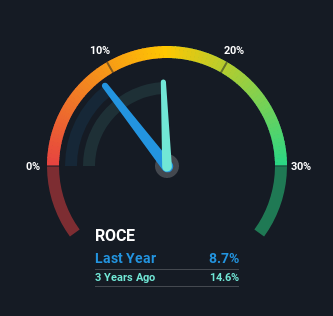- Israel
- /
- Energy Services
- /
- TASE:LAPD
Returns On Capital Signal Tricky Times Ahead For Lapidoth Capital (TLV:LAPD)
There are a few key trends to look for if we want to identify the next multi-bagger. Ideally, a business will show two trends; firstly a growing return on capital employed (ROCE) and secondly, an increasing amount of capital employed. This shows us that it's a compounding machine, able to continually reinvest its earnings back into the business and generate higher returns. However, after briefly looking over the numbers, we don't think Lapidoth Capital (TLV:LAPD) has the makings of a multi-bagger going forward, but let's have a look at why that may be.
Return On Capital Employed (ROCE): What is it?
Just to clarify if you're unsure, ROCE is a metric for evaluating how much pre-tax income (in percentage terms) a company earns on the capital invested in its business. To calculate this metric for Lapidoth Capital, this is the formula:
Return on Capital Employed = Earnings Before Interest and Tax (EBIT) ÷ (Total Assets - Current Liabilities)
0.087 = ₪336m ÷ (₪7.2b - ₪3.3b) (Based on the trailing twelve months to December 2021).
Therefore, Lapidoth Capital has an ROCE of 8.7%. On its own that's a low return, but compared to the average of 6.4% generated by the Energy Services industry, it's much better.
See our latest analysis for Lapidoth Capital

While the past is not representative of the future, it can be helpful to know how a company has performed historically, which is why we have this chart above. If you're interested in investigating Lapidoth Capital's past further, check out this free graph of past earnings, revenue and cash flow.
What The Trend Of ROCE Can Tell Us
When we looked at the ROCE trend at Lapidoth Capital, we didn't gain much confidence. Over the last five years, returns on capital have decreased to 8.7% from 16% five years ago. Although, given both revenue and the amount of assets employed in the business have increased, it could suggest the company is investing in growth, and the extra capital has led to a short-term reduction in ROCE. If these investments prove successful, this can bode very well for long term stock performance.
On a side note, Lapidoth Capital's current liabilities have increased over the last five years to 46% of total assets, effectively distorting the ROCE to some degree. If current liabilities hadn't increased as much as they did, the ROCE could actually be even lower. And with current liabilities at these levels, suppliers or short-term creditors are effectively funding a large part of the business, which can introduce some risks.
What We Can Learn From Lapidoth Capital's ROCE
Even though returns on capital have fallen in the short term, we find it promising that revenue and capital employed have both increased for Lapidoth Capital. And long term investors must be optimistic going forward because the stock has returned a huge 257% to shareholders in the last five years. So while the underlying trends could already be accounted for by investors, we still think this stock is worth looking into further.
One more thing to note, we've identified 3 warning signs with Lapidoth Capital and understanding these should be part of your investment process.
While Lapidoth Capital isn't earning the highest return, check out this free list of companies that are earning high returns on equity with solid balance sheets.
New: AI Stock Screener & Alerts
Our new AI Stock Screener scans the market every day to uncover opportunities.
• Dividend Powerhouses (3%+ Yield)
• Undervalued Small Caps with Insider Buying
• High growth Tech and AI Companies
Or build your own from over 50 metrics.
Have feedback on this article? Concerned about the content? Get in touch with us directly. Alternatively, email editorial-team (at) simplywallst.com.
This article by Simply Wall St is general in nature. We provide commentary based on historical data and analyst forecasts only using an unbiased methodology and our articles are not intended to be financial advice. It does not constitute a recommendation to buy or sell any stock, and does not take account of your objectives, or your financial situation. We aim to bring you long-term focused analysis driven by fundamental data. Note that our analysis may not factor in the latest price-sensitive company announcements or qualitative material. Simply Wall St has no position in any stocks mentioned.
About TASE:LAPD
Lapidoth Capital
Provides drilling and related services in Israel, Romania, the United States, Poland, rest of Europe, and internationally.
Excellent balance sheet with proven track record.
Market Insights
Community Narratives



